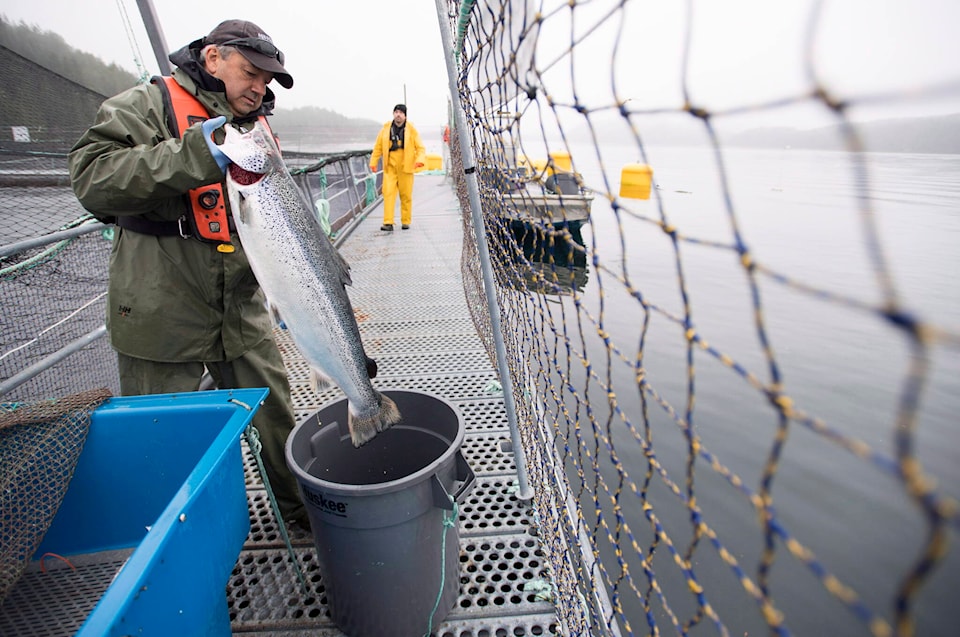No fish farms does not necessarily mean no sea lice, according to two aquaculture industry studies.
The annual studies released by MOWI Canada and the Salmon Coast Field Station (SCFS) in October, suggest that no location, whether close to a salmon farm or not, has demonstrated consistent levels of sea lice prevalence in nearly a decade of sampling.
The industry injects $1.5 billion into the regional economy and employs some 6,500 workers scattered along the coast of Vancouver Island. However, with the Liberal government’s announcement in 2020 to phase out the practice, 24 combined fish farms have been shuttered in the Discovery Islands and Broughton Archipelago, leaving about half a dozen left.
The MOWI study, entitled was conducted in collaboration with Mainstream Biological Consulting, Pacifius Biological Service as well as the Kitasoo/Xai’xais First Nation.
The studies also found that during their lives, anywhere between 70 and 95 per cent of wild juvenile salmon hosted 2 or less sea lice, irrespective of the research or whether or not they were sampled near or at a salmon farm.
“The data that has been collected by these independent researchers, now shows that sea lice are present on juvenile salmon, and are highly variable from year to year,” says Mowi Director of Communications Ian Roberts. “This is due to a myriad of environmental influences, regardless of salmon farms operating or not.”
Researchers based their findings on two variables: prevalence and intensity (number of sea lice per fish). While there are cases that sea lice can be prevalent but less intense, and vice versa.
In the Discovery Islands, for example, prevalence was between four and eight per cent in 2017 and 2018, relatively low. But that prevalence increased in 2019 and 2020, to 29 and 21 per cent, respectively. With farms removed, prevalence was down to nine per cent this past spring.
“When we look at the infestation rate, in the midpoint of the Discovery Islands where the fish farms were removed, the fish sample over a six-year range, with two infestation rates that are lower, two that are higher, and two smack dab in the middle,” says Lance Stewardson, lead biologist of the study with the Mainstream Biological team. “The infestation without farms is pretty much the median.”
The Broughton Archipelago, in the eight years of monitoring, has been relatively stable. There hasn’t been much of a change. However, in 2022, there happened to be the highest infestation since monitoring began in 2016, with fewer farms.
READ MORE:
“The ocean is a big place. There are natural reservoirs providing and responsible for infestation of juvenile salmon. Water quality, temperature can all play a factor. Removing the farms doesn’t necessarily mean the end of sea lice,” Stewardson says.
“What we’ve seen is that no farms doesn’t necessarily equal no lice.”
However, fish farm opponents remain skeptical. Alexandra Morton, who has been whose research on wild salmon and sea lice was key to the decision by the Federal Fisheries and Oceans Department (DFO) to close all open net fish farms says the numbers found in the study are a bit skewed.
Morton says that 708 of the fish that were tested in the 45 sites in Broughton, nearly half were caught before fish farms on regulation routes, while only 68 were caught beside fish farms.
“It will be interesting to go back to this data when more of the farms deep in the Archipelago are removed,” Morton says. “The impact of where the farms are placed in archipelago environments will be known.”
For the results conducted in the Discovery Islands region, Morton alleges that the three divisions made up in the study, pre-exposure and post exposure, are not valid.
“The information on the post exposure region, for example, has always included active fish farms,” Morton says. “It also includes information on the only active salmon farm in the Discovery Islands.”
That farm, Shaw Point, had the worst performing area in 2022, according to a report by the DFO.
All sides agree, however, that more long-term monitoring needs to take place before an imminent conclusion is drawn regarding the impact open net fish farms have had on the infestation of sea lice.
MOWI, however, stands by its data.
“Some campaigners are determined to lead the public to believe that sea lice disappear when farms are not operating,” says Roberts. “The data shows that this is simply not true.”
This study, along with data shown to support it, will be a tricky element in the weeks and months ahead, as the Federal government goes full steam ahead with their decision to close all open-net fish farms on B.C.’s coast by 2025.
Edward Hitchins
edward.hitchins@campbellrivermirror.com
Like us on and follow us on



